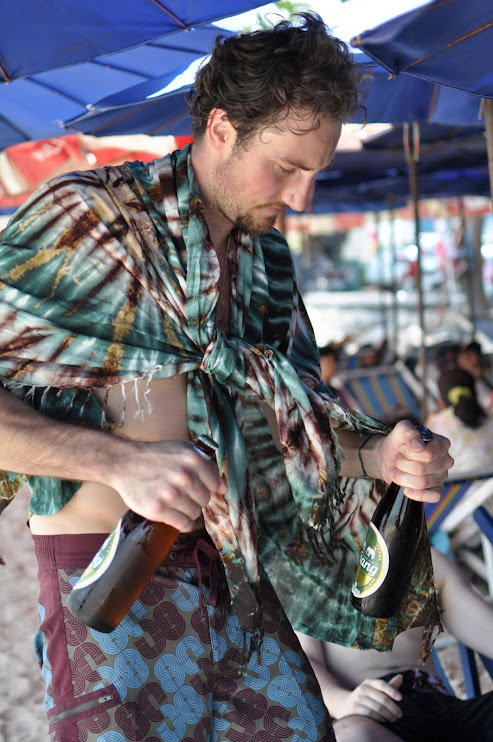From time to time, to lessen the guilt of possessing such a good camera and not using it as much as I should, I plan to use this medium to exhibit interesting photos I've had the chance to shoot here. So without further adiue, here some pics from the three-day-weekend I recently spent in Kyoto and Osaka.
 |
| This fox guards the entrance to the Fushimi-Inari-Taisha, a shrine-covered mountain dedicated to the gods of rice and sake. The fox in Japanese folklore is traditionally seen as a sacred and mysterious figure that's capable of possessing humans, by entering them under the fingernails. All of the foxes at Fushimi-Inari are messengers of the god of cereal, often being depicted as holding some key to the rice granary in their mouths. |
 |
| Fushimi-Inari is home to tens of thousands of orange Torii gates covering the various trials on Inari-san (the mountain). |
 |
| Merchants and manufacturers can dedicate Torii gates by purchasing them in the hopes that they'll be blessed by success and wealth. The company's Kanji is engraved on the supporting beams. |
 |
| Josh Buck tries his hand at lifting the Omokaru-Ishi (literally translated as heavy-light stone). Before attempting to lift the stone you're meant to make a wish and if the weight is lighter than your expectation that wish will come true......apparently.......Forward this to 10 friends in the next hour or you'll have bad luck for a year. SSDD |
 |
| Jim Buell walks along one of the tree-lined paths NOT covered by Torii gates at Fushimi-Inari |
 |
| The Japanese Maples were putting on their final brilliant display before the harsh winter months arrived. This event draws millions of people to Kansai every year. Thankfully, due to our early arrival at the shrine, we pretty much had the entire mountain to ourselves. |
 |
| Kiyomizu-dera was original built in 798, however, like many of Japan's famous buildings, the present structure is a reconstruction (dating from 1633, still older than my country!). One of Kyoto's most famous landmarks, this temple houses the Otowa-no-taki waterfall, where visitors drink the sacred water to improve any number of ailments (including poor test scores). |
 |
| Most Shinto shrines contain a Chouzuya (purifying basin) where you're to clean your hands and mouth before entering the shrine. The etiquette here, like most things Japanese, is very important. One should always begin by ladling water over the right hand before the left, and making sure that the water falls on the ground NOT back in the basin. |
 |
| Wandering around the Gion neighborhood in Kyoto we ran into some Maiko-san (apprentice Geisha) who kept insisting that they were genuine. Apparently with Kyoto being such a tourist destination there are young women dressing up in elaborate garb and soliciting money from the people who photograph them. Maiko-san typically have longer sleeves and more pink in their face make-up than Geisha. |
 |
| Kinkaku-ji (The Golden Pavilion) is one of Japan's best-known sights. Here it is framed by Autumn leaves. |
 |
| This was my favorite photograph from the trip. To me it is quintessential Japan. |
 |
| Here Josh Buck meditates on the intricacies of Ryoan-ji one of the most famous Zen rock gardens. |
 |
| This is the reconstructed Osaka-jo, which was burned down in 1583 by the armies of Tokugawa Ieyasu. |
 |
| The Dotombori arcade is home to a lively collection of bars and restaurants selling every type of Japanese food imaginable. Here a dragon bursts through the wall of a building to proclaim the deliciousness of the restaurant's fare. |
 |
| A street vendor expertly turns cooking Tako-yaki (fried octopus balls). |
 |
| Here is a look at the famed Ebisu-bashi (the main foot bridge over the Dotomburi canal) dedicated by a beer company. As a response a rival (Asahi) has constructed a towering 10 meter glowing neon sign directly over the bridge. |























No comments:
Post a Comment